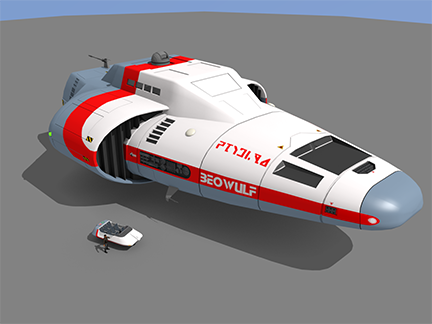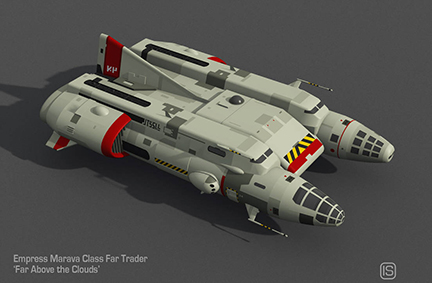Hi Guys,
Just wondered if any one on this forum has ever created a standard system for determine what a registration value should be for any given hull in their campaign(s).
What I'm doing a little at a time, here and there, is coding for my own enjoyment, an application that will let me (in text mode only) have a GM assistant for tracking details of Traveller Universe activity on either the behalf of the player character(s) or on behalf of the GM. The idea was to have something that would allow me to start up a campaign log for ship activities, freight manifests, freight spot market contracts, passenger manifests, and the like. Each "campaign" would require that I be able to add a "Ship" for the player character in question - detailing its specifics such as hull class (dTon displacement), Jump capability, maneuver drive thrust, power plant output, etc.
Then I saw the one "field" in the JTAS form that almost never gets filled in by myself...
Ship's Registration Number
As I thought about it, and the idea that the registration number, once assigned, never changes - I started to think in terms of Standardization. How would some flunky in the Third Imperium government have set this up so that no ship could ever have the same registration value for their ship.
This is what I devised and the thinking that went into it.
Sector ID value - I am thinking of using either the first two letters of each word for a sector name, or the first four letters of the sector if there is but one word.
World Name - First four letters of the World name
Shipyard Number - in case any given world has more than one shipyard in system. For instance, if Earth had 2 shipyards in orbit around Earth, one shipyard at a down port on Earth, 1 shipyard on a down port at Mars, and a shipyard in orbit around Mars - we would have a total of 5 shipyards.
Contract Type - generally speaking, the first letter of this code would be either C for Civilian, S for Scout, or N for Naval. The Second single letter code would be either S for Star ship, or B for Boat. If instead, it has an X, it stands for Experimental prototype.
Contract Year - the year the contract was drawn up. This is usually earlier than the time the ship's hull is laid down.
Contract Number - Unless we have massive star ports out there building thousands or millions of hulls per year - the contract number value for any given hull is likely going to be less than 6 digits.
As an idea, any GM can simply use a spreadsheet to get a list of all of those worlds whose worlds have a capability for building star ships or boats - and then take it from there. If they had access to a computer program, they could even set it up to randomly generate the age of the ship, subtract the age of the ship from the current campaign year, and generate the year aspect of the contract by making the year the contract was signed/ratified as being 2d6 months earlier than when the ship's hull was laid down.
If there was a table of all possible starports within a region, you might be able to simply randomly generate the Registration number for any given randomly encountered ship as just one more detail possible. Part numbers of various equipment manufactured for use with this ship might have the ship registration ID stamped into the metal or etched into the circuit boards, or micro-laser burned into various locations as anti-theft traps or what have you.
Just thinking aloud and sharing ideas. If anyone can think of any other details that should be included, let me know. For instance? I thought about using an identifier for whether or not the ship was built in the boarders of the Third Imperium or outside the borders, but realized that if anyone is using the standard as outlined, it would be an Imperial compliant ship in the first place. Each "nationality" or race would have its own unique method for assigning registration numbers. This I figure, might be what the Starport Authority would mandate for any ships built within its sphere of influence, or would look closely at for any ship that calls in port.
Ideas? Criticisms?
Just wondered if any one on this forum has ever created a standard system for determine what a registration value should be for any given hull in their campaign(s).
What I'm doing a little at a time, here and there, is coding for my own enjoyment, an application that will let me (in text mode only) have a GM assistant for tracking details of Traveller Universe activity on either the behalf of the player character(s) or on behalf of the GM. The idea was to have something that would allow me to start up a campaign log for ship activities, freight manifests, freight spot market contracts, passenger manifests, and the like. Each "campaign" would require that I be able to add a "Ship" for the player character in question - detailing its specifics such as hull class (dTon displacement), Jump capability, maneuver drive thrust, power plant output, etc.
Then I saw the one "field" in the JTAS form that almost never gets filled in by myself...
Ship's Registration Number
As I thought about it, and the idea that the registration number, once assigned, never changes - I started to think in terms of Standardization. How would some flunky in the Third Imperium government have set this up so that no ship could ever have the same registration value for their ship.
This is what I devised and the thinking that went into it.
Sector ID value - I am thinking of using either the first two letters of each word for a sector name, or the first four letters of the sector if there is but one word.
World Name - First four letters of the World name
Shipyard Number - in case any given world has more than one shipyard in system. For instance, if Earth had 2 shipyards in orbit around Earth, one shipyard at a down port on Earth, 1 shipyard on a down port at Mars, and a shipyard in orbit around Mars - we would have a total of 5 shipyards.
Contract Type - generally speaking, the first letter of this code would be either C for Civilian, S for Scout, or N for Naval. The Second single letter code would be either S for Star ship, or B for Boat. If instead, it has an X, it stands for Experimental prototype.
Contract Year - the year the contract was drawn up. This is usually earlier than the time the ship's hull is laid down.
Contract Number - Unless we have massive star ports out there building thousands or millions of hulls per year - the contract number value for any given hull is likely going to be less than 6 digits.
As an idea, any GM can simply use a spreadsheet to get a list of all of those worlds whose worlds have a capability for building star ships or boats - and then take it from there. If they had access to a computer program, they could even set it up to randomly generate the age of the ship, subtract the age of the ship from the current campaign year, and generate the year aspect of the contract by making the year the contract was signed/ratified as being 2d6 months earlier than when the ship's hull was laid down.
If there was a table of all possible starports within a region, you might be able to simply randomly generate the Registration number for any given randomly encountered ship as just one more detail possible. Part numbers of various equipment manufactured for use with this ship might have the ship registration ID stamped into the metal or etched into the circuit boards, or micro-laser burned into various locations as anti-theft traps or what have you.
Just thinking aloud and sharing ideas. If anyone can think of any other details that should be included, let me know. For instance? I thought about using an identifier for whether or not the ship was built in the boarders of the Third Imperium or outside the borders, but realized that if anyone is using the standard as outlined, it would be an Imperial compliant ship in the first place. Each "nationality" or race would have its own unique method for assigning registration numbers. This I figure, might be what the Starport Authority would mandate for any ships built within its sphere of influence, or would look closely at for any ship that calls in port.
Ideas? Criticisms?



